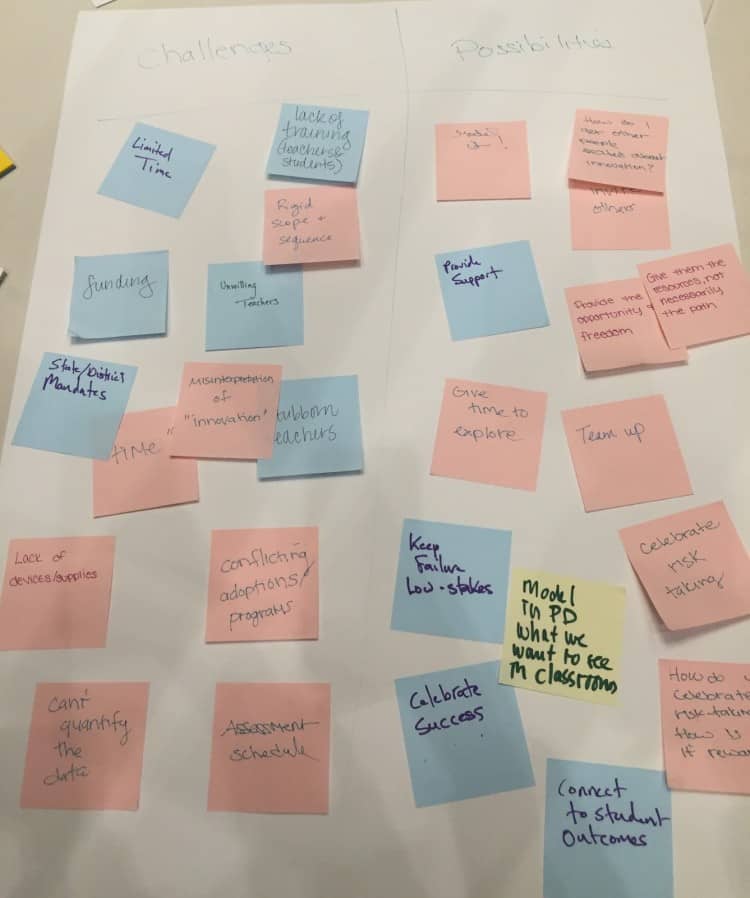6 Ways to Design a PD Session that Tackles Big School Challenge

By Margaret Powers
A few weeks ago, Kaleb Rashad and I facilitated a session on Practical Processes to Creating a Schoolwide Innovation Culture during the SXSWedu Ready Go! Summit. We wanted to share some of our goals for our session here as a way to make our process more transparent and encourage the practice of publicly reflecting on professional learning workshops.
The crowd in our session (it was standing-room only!) speaks to the fact that educators across the country (and beyond) are thinking deeply about this challenge and recognizing that it is time to get to work. In order to do this work, we need to pool our resources, engage in meaningful inquiry together, and share what has worked and what hasn’t so we can try again and try to do better.
Designing a Teacher PD Session
When we designed our session, we knew that we wanted to accomplish six things:
1. Ask the big questions and the concrete ones
To meet this goal, we thought carefully about the guiding questions we wanted to frame the session around and ultimately came up with two central ones that we revisited throughout the session.
The first question, “What can I do to inspire creativity, imagination, and innovation?” was meant to (re)direct attention back to the participants and remind everyone that innovation must start with ourselves. We have to make a conscious choice to be innovative and to engage in teaching and learning practices that support that decision.
This means uncovering your own “why” for innovating and keeping it at the forefront of your mind because as Kaleb said in our session, “Changing and innovating school culture is impossible. Now let’s get to work.” In order to persevere through something as challenging as shifting culture, you have to be clear about your own why and committed to starting with yourself before asking others to change.
Our second question was, “How might we create a culture of innovation?” This was the big question, the overarching challenge that we offered up to the community in the room and then tried to provide a framework for each person to begin addressing it.
2. Model what we believe in


We did not want to just talk about an innovative culture or ways to create one, we wanted participants to experience a workshop that was:
- Innovative
- Practical
- Engaging
- Collaborative
- Relevant
To do this, we wove in interactive activities that allowed each participant to respond using their own context and experiences. For example, we started the session with a T-chart where tables could to a “brain dump” to free themselves of the many possible constraints and concerns they might be carrying about trying to innovate in their own context. We felt this was a way to respond to the reality of how busy and overwhelmed many educators are, especially when they are trying to create change, and particularly at a non-stop conference like SXSWedu.
First round brainstorming: “yes, but…”
Total shut down! Good thing #SXReadyGo attendees are good sports#SXSWedu pic.twitter.com/OK2dBGfQDI— Lindsey Own (@LindseyOwn) March 7, 2016
Likewise, we later invited tables to work together as a team to engage in some inquiry and shared brainstorming, ensuring that the session was active and made use of the many levels of expertise already in the room. We felt it was critical for people to have time to work together and to work on problems they were experiencing themselves, not just theoretical ones or models we could present.
3. Honor the need for time to think/work/process
I have attended many conference sessions that were full of amazing resources and great ideas but so often I left wishing I had some time to work through it all and dive deeper. Our hope for the Ready Go! Summit was to create a space in the SXSWedu schedule for participants who wanted to go deeper and engage with the content.
Therefore, we built-in time in the session for participants to simply learn and engage in inquiry together. Instead of just talking at the group, we wanted them to own their investigations of concrete behaviors and processes which can help shift culture towards innovation. We provided some initial resources and the time to read them, review them with a team, and pull out insights and next steps from them.
We also offered a shared Google Doc as a place for the community to put up resources for the entire group and increased the shared knowledge of the room. Instead of having to wait until they got home to do the inquiry and building understanding, to synthesize takeaways and next step, we wanted that work to happen together, in community that was built in the room.
4. Share valuable resources, tools and processes
Throughout the session, Kaleb and I offered a variety of tools and resource that participants could take back and apply in their own contexts. We wanted each activity to be something that added value to our session and also things that could be used again with other groups that participants might work with when trying to shift their school culture. The survey we shared (What’s your appetite for innovation?) is a great example of this because while it allowed everyone to self-assess where they are now in terms of everyday behaviors that support a culture of innovation, it is also something that could be adapted and used in participants’ communities.
In addition to concrete artifacts, like the survey and the visuals about moving from compliance to innovation and from convergent to divergent thinking using PBL or design thinking, we offered thinking tools as well. We used the “See, Think, Wonder” visual thinking routine and a “yes, and” brainstorming activity so the group could experience some ways of shifting culture and mindsets themselves.
Showing and telling are often not enough, creating change requires doing and we knew that that had to be part of our session as well – doing in the sense of thinking differently, acting differently, and creating differently. We gave participants time near the end to create artifacts (e.g., storyboard, graphic organizer, flow chart, timeline, project card) with small, specific next-steps they wanted to take based on the inquiry work they had done. Here is the example we provided them:


5. Understand themes
At the end of the session, we collected all of the T-charts created by the different groups in order to report out themes we found. The constraints and challenges that people listed, regardless of their school context, were quite similar. Here are the most popular ones:
- Time
- Fear
- Buy-in
- Mindsets
- Funding/resources
- Lack of PD
- Testing and Standards
- Culture (of trust, growth)
6. Offer insights

With those challenges in mind, after engaging in shared inquiry and creating some type of concrete artifact with next steps, we invited the group to share a few “baby steps” they planned to take in their schools to address these issues. Here are the ideas we collected:
- Model the innovative behaviors we want to see.
- Provide support for people to engage in the modeled behaviors.
- Team up and don’t try to innovate alone.
- Celebrate risk-taking by making failure acceptable and encouraged.
- Make connections to student outcomes
- Share your own mistakes as an innovator in the school by starting with I and model the behaviors
- “Yes, and” people by making an effort to continually build on others’ ideas
- Create a fun environment by creating spaces that are conducive and supportive of innovative behaviors
- Ask more questions
- Get out of your office/classroom
- Use a stoke everyday (Here are some from the d.School)
- Exchange jobs with someone else in the school for a day to get a fresh perspective and gain empathy/understanding for others
- Trade something (e.g., furniture, tools, etc) with someone in a different workspace
- Trade classrooms for a day (but keep your students)
- Move your furniture everyday
- Name and share your own and others’ passions and strengths
- Shadow an administrator
- Shadow a student
- Use design thinking with students and teachers to focus on problems uncovered at school (e.g. the schedule)
- Use storytelling as a powerful tool to help student, teacher, and admin voices be heard and develop empathy
- Create Bug Lists in a public space for all community members to share problems in the school and ideas for solving them
In addition to these resources we wanted to offer some concrete next steps you could take depending on your role within a school.
Check out the resources below and explore ways you can hack these plans for your own school, working with stakeholders throughout the building to slowly create change.
Final Reflections
Shifting school culture to support innovation is an extremely hard undertaking. When you sign up to tackle a challenge like this, there are seemingly endless obstacles in front of you. The good news is that even if you feel like you are doing this work in isolation, in the silo of your classroom, your grade team, or your school, you are not alone.
And together, if we can create enough small shifts in our classrooms and our schools, the change we can affect is powerful and contagious.

For more, see:
Margaret Powers is a Technology Coach and manages the Pre-K-5th IDEA Studio at an independent school outside Philadelphia. Follow her on Twitter: @mpowers3.
Stay in-the-know with all things EdTech and innovations in learning by signing up to receive the weekly Smart Update.








0 Comments
Leave a Comment
Your email address will not be published. All fields are required.